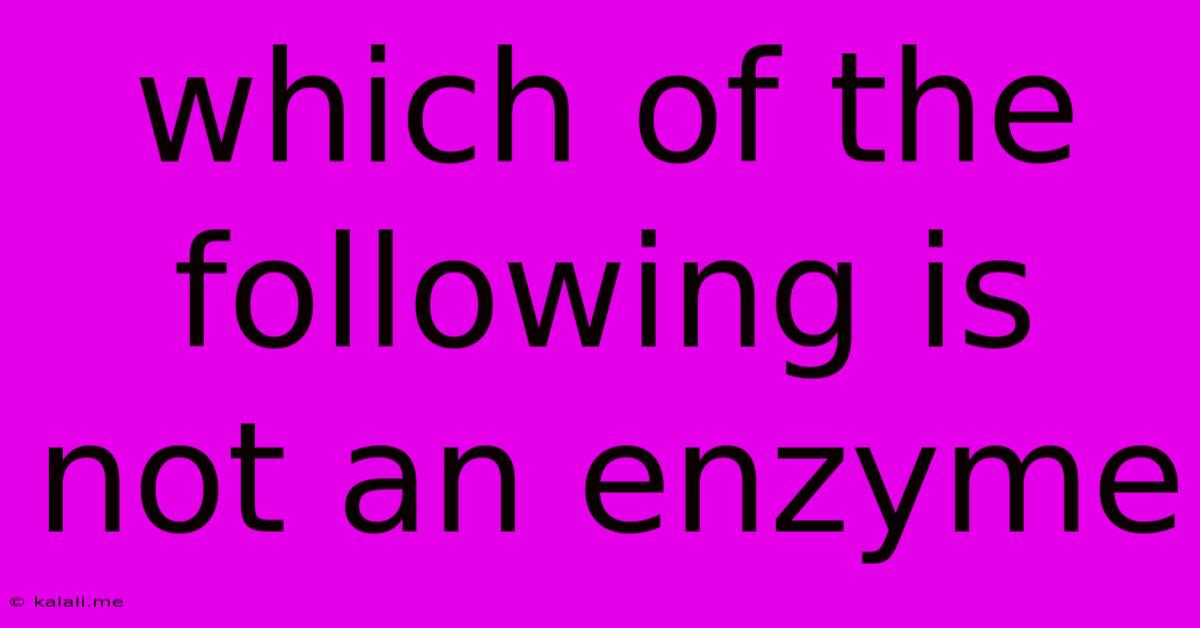Which Of The Following Is Not An Enzyme
Kalali
Jun 13, 2025 · 3 min read

Table of Contents
Which of the Following is Not an Enzyme? Understanding Enzyme Function and Non-Enzyme Molecules
Enzymes are biological molecules, primarily proteins, that act as catalysts in living organisms. They speed up chemical reactions without being consumed in the process. Understanding what constitutes an enzyme and what doesn't is crucial in biochemistry. This article will explore the characteristics of enzymes and delve into why certain molecules are not classified as enzymes.
What are Enzymes?
Enzymes are highly specific, meaning they only catalyze particular reactions. This specificity is due to their unique three-dimensional structures, which form active sites that precisely bind to substrate molecules. The active site's shape and chemical properties determine which substrates the enzyme can interact with. This process facilitates the formation of the enzyme-substrate complex, a crucial step in catalyzing the reaction. Key characteristics of enzymes include:
- Catalytic activity: Enzymes significantly increase the rate of biochemical reactions.
- Specificity: Enzymes act on specific substrates.
- Regulation: Enzyme activity can be regulated to control metabolic pathways.
- Protein structure (mostly): Most enzymes are proteins, although some are RNA molecules (ribozymes).
Molecules That are NOT Enzymes
Several molecules might be confused with enzymes due to similar functions or properties, but they lack the defining characteristics of a true enzyme. Let's examine some examples:
1. Hormones
Hormones are chemical messengers that regulate various physiological processes. While they can influence metabolic rates indirectly, they do not directly catalyze reactions like enzymes do. They exert their effects by binding to receptors and triggering signaling cascades. Examples include insulin and testosterone. These regulate metabolic processes, but they aren’t enzymes themselves.
2. Antibodies
Antibodies are proteins produced by the immune system to recognize and neutralize foreign substances (antigens). They bind specifically to antigens, but their function is to mark them for destruction, not to catalyze a chemical reaction.
3. Receptors
Cellular receptors are proteins that bind to specific signaling molecules, such as hormones or neurotransmitters. Their role is to transduce signals across the cell membrane, initiating intracellular processes. Like antibodies, they lack the catalytic function essential for enzymes.
4. Structural Proteins
Structural proteins like collagen and keratin provide support and shape to cells and tissues. Although they have specific binding sites, they don't accelerate chemical reactions. Their primary function is structural.
Identifying Non-Enzymes: Key Distinctions
The crucial difference lies in their catalytic activity. If a molecule doesn't significantly increase the rate of a specific biochemical reaction without being consumed in the process, it's not an enzyme. Other distinctions include the lack of a defined active site or inability to form an enzyme-substrate complex. Understanding these distinctions helps differentiate between enzymes and other biomolecules with potentially overlapping functions.
In Conclusion
While many molecules participate in biological processes and might appear to share similarities with enzymes, the defining characteristic is their catalytic activity. Hormones, antibodies, receptors, and structural proteins, while critical for life, lack this essential property, making them distinct from enzymes. This understanding is paramount in comprehending the complexity and intricacy of biochemical pathways and cellular function.
Latest Posts
Latest Posts
-
An Electron Is Accelerated From Rest Through A Potential Difference
Jun 14, 2025
-
Greater Than Less Than Calculator Decimals
Jun 14, 2025
-
What Are Two Elements That Are Liquid At Room Temperature
Jun 14, 2025
-
Gpa Requirements For Valdosta State University
Jun 14, 2025
-
At What Temperature Do Celsius And Fahrenheit Scales Coincide
Jun 14, 2025
Related Post
Thank you for visiting our website which covers about Which Of The Following Is Not An Enzyme . We hope the information provided has been useful to you. Feel free to contact us if you have any questions or need further assistance. See you next time and don't miss to bookmark.